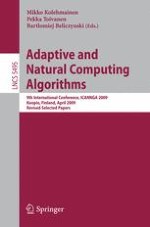2009 | Book
Adaptive and Natural Computing Algorithms
9th International Conference, ICANNGA 2009, Kuopio, Finland, April 23-25, 2009, Revised Selected Papers
Editors: Mikko Kolehmainen, Pekka Toivanen, Bartlomiej Beliczynski
Publisher: Springer Berlin Heidelberg
Book Series : Lecture Notes in Computer Science
